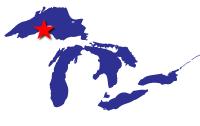Torch Lake AOC
Heather Williams
([email protected])
312-886-5993
On this page:
Overview
The Torch Lake Area of Concern (AOC) is one of the 31 U.S.-based AOCs across the Great Lakes designated under the 1987 Great Lakes Water Quality Agreement. The boundary of the Torch Lake AOC includes Torch Lake and its immediate environs. Immediate environs are areas along the shore of Torch Lake where waste from the production of copper contributed directly to the contaminant loadings of Torch Lake.
Mining of native copper found in the region's bedrock formations began during the 1840s and continued until 1968 when all mining related operations ceased. Waste products from industrial milling, smelting and leaching operations of the mined ore are the main source of pollution in Torch Lake. In addition to copper, other contaminants of concern in the AOC are heavy metals, PCBs and polycyclic aromatic hydrocarbons. The Torch Lake AOC overlaps with a portion of the Torch Lake Superfund site.
Beneficial Use Impairments
An interim success of remediation and restoration work is removing Beneficial Use Impairments (BUIs). BUIs are designations given by the International Joint Commission, representing different types of significant environmental degradation. BUIs are removed when sufficient environmental health improvements have been demonstrated through monitoring. The list below shows which BUIs have been removed, and which remain. Once all BUIs are removed, the process of delisting the AOC can begin.
- Restrictions on Fish and Wildlife Consumption
- Degradation of Benthos
- Fish Tumors or Other Deformities – Removed April 2007
Remediation and Restoration Work
EPA has continually worked with federal, state and local partners to identify and implement remediation and restoration work with the ultimate goal of removing the AOC designation. Evolving projects aimed at improving the environmental health of Torch Lake include the Torch Lake Great Lakes Legacy Act projects and the Torch Lake Degradation of Benthos BUI benthos pilot study and restoration projects.
The recently completed Torch Lake Degradation of Benthos BUI pilot study was funded by the Great Lakes Restoration Initiative. The project included construction of a series of pilot-scale shoreline capping and habitat restoration test plots. Construction of the pilot study test plots was completed in spring 2021 with monitoring performed in fall 2021, 2022, and 2023. Results of the pilot study indicated the potential to improve the density and diversity of the Torch Lake benthic community through the development of wetland habitat restoration. A Benthos Habitat Restoration project is proposed for shoreline and near-shore areas of Torch Lake which may results in approximately 45 acres of restored habitat to improve the benthic community.
Torch Lake Great Lakes Legacy Act Focused Feasibility Study
On August 20, 2019, EPA signed a Great Lakes Legacy Act (GLLA) Project Agreement with Honeywell International, Inc. to perform a focused feasibility study at the Torch Lake AOC. This is the first GLLA project agreement signed at the Torch Lake AOC. The study is being performed in two areas of Torch Lake, the Lake Linden Recreational Area and the Hubbell Processing Area.
The study is focusing on developing remedial alternatives for addressing PCB, lead and arsenic contaminated sediment in both areas, as well as mining waste abandoned in the lakebed in the Hubbell Processing Area. Addressing contaminated sediment in these two areas will contribute to removing the Restrictions on Fish and Wildlife Consumption BUI.
The project agreement included removal of hazardous piles along Torch Lake for source control. Source control work, conducted by Honeywell, was completed in fall 2019. Additional sampling took place in summer of 2020, as well as in 2023 and 2024.
The feasibility study for the Lake Linden Recreation Area was finalized in 2023 and included the preferred remedial alternative, or cleanup option, of dredging to remove contaminated sediment followed by a clean sand cover placement. The GLLA Project Agreement was modified on January 22, 2024 to include the remedial design of the Lake Linden Recreation Area. Remedial design is in progress and will continue through 2025, with the anticipated cleanup taking place in 2026.
The feasibility study for the Hubbell Processing Area is anticipated to be complete in 2025. A drum removal pilot study was performed in fall 2024 by EPA’s contractors as part of feasibility study, to assist in the evaluation of potential cleanup options. Along with contaminated sediment, approximately 400 drums are present on the lakebed in the Hubbell Processing Area in water depths ranging from 20 to 70 feet of water. Results of the drum removal pilot study are currently being evaluated and will aid in the development of remedial alternatives.
Torch Lake Public Action Council


